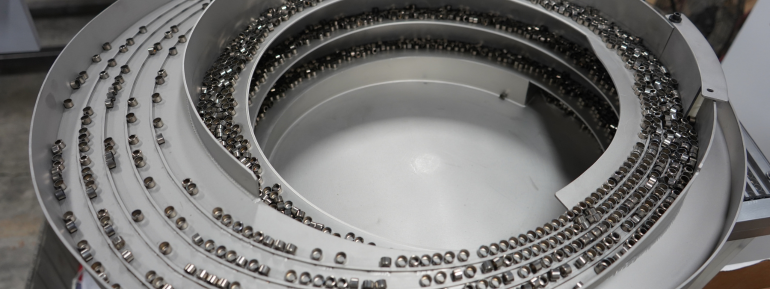Hoosier Feeder Company has quickly built a reputation for building some of the most efficient feeder systems (or parts handling systems) available. A large percentage of the systems we create are vibratory, which means they use vibration to “feed” or orient and discharge parts in a repeatable position for the assembly process. But how exactly does a vibratory feeder system work?

- It Starts with a Bowl – The vibratory feeder is loaded with random bulk parts in the center of the bowl, and has an incline spiral track to transport parts up to the top of the feeder. Once parts make it to the top of the spiral track, the remaining tooling of the feeder is installed on a slight down angle to increase part separation.
- Add Vibration – The vibration comes from electromagnetic coils that lift the parts forward and set them back down as much as 120 times per second to propel parts through the feed system.
- Bring on the tooling – As parts travel through the conversion area of the feeder, they can be introduced to mechanical tooling features that manipulate certain orientations and allow others to pass to convert as many orientations as possible to a common orientation.
- Final verification – Parts are then introduced to mechanical or pneumatic tooling that rejects any part that is not in the proper orientation into the return pan that directs them back into the center of the feeder to start the process over again.
- Keep it moving – Once parts are properly aligned, they enter into confinement tooling that maintains orientation and transports them downstream to the next process in the assembly.
At Hoosier Feeder Company, our vibratory feeders are highly regarded for their ability to reliably handle parts of all sizes and shapes. We offer a complete line of vibratory feeder systems from 6 to 36 inches in diameter. Our vibratory feeder systems can even be designed to feed multiple, complicated parts, including those that require frequent change-over.
Contact Hoosier
Do you work in an industry that uses – or could benefit from using – vibratory feeder systems? What issues do you currently run into with existing vibratory feeder systems? Contact Hoosier Feeder Company today to learn how we can help improve the efficiency of your feeder systems.
April 13, 2016
Related Topics: Vibratory Feeders